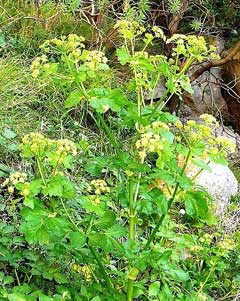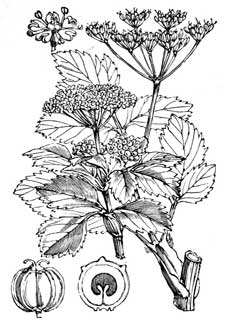 |
|
http://commons.wikimedia.org/wiki/User:Esculapio |
 |
| http://commons.wikimedia.org/wiki/File:Smyrnium_olusatrum.jpg |
Translate this page:
Summary
Physical Characteristics

 Smyrnium olusatrum is a BIENNIAL growing to 1.2 m (4ft) by 0.7 m (2ft 4in).
Smyrnium olusatrum is a BIENNIAL growing to 1.2 m (4ft) by 0.7 m (2ft 4in).
See above for USDA hardiness. It is hardy to UK zone 6 and is not frost tender. It is in flower from May to June, and the seeds ripen from June to August. The species is hermaphrodite (has both male and female organs) and is pollinated by Insects. The plant is self-fertile.
It is noted for attracting wildlife.
Suitable for: light (sandy), medium (loamy) and heavy (clay) soils and prefers well-drained soil. Suitable pH: mildly acid, neutral and basic (mildly alkaline) soils. It can grow in semi-shade (light woodland) or no shade. It prefers moist soil. The plant can tolerate maritime exposure.
UK Hardiness Map
US Hardiness Map
Synonyms
Plant Habitats
Woodland Garden Sunny Edge; Dappled Shade; Shady Edge; Hedgerow;
Edible Uses
Edible Parts: Flowers Leaves Root Shoots Stem
Edible Uses: Condiment
Leaves and young shoots - raw in salads or cooked in soups, stews etc[2, 5, 8, 12, 27, 37, 115, 183]. The plant comes into growth in the autumn and the leaves are often available throughout the winter[5, 52]. They have a rather strong celery-like flavour and are often blanched (by excluding light from the growing plant) before use[183]. Leafy seedlings can be used as a parsley substitute[183]. Stem - raw or cooked[2, 5, 8, 12, 27, 37, 53, 115]. It tastes somewhat like celery, but is more pungent[17, 244]. The stem is often blanched (by excluding light from the growing plant) before use[183]. Flower buds - raw[12, 52]. Added to salads, they have a celery-like flavour[K]. The spicy seeds are used as a pepper substitute[52, 183]. Root - cooked. Boiled and used in soups, its flavour is somewhat like celery. The root is said to be more tender if it has been kept in a cool place all winter[183].
References More on Edible Uses
Medicinal Uses
Plants For A Future can not take any responsibility for any adverse effects from the use of plants. Always seek advice from a professional before using a plant medicinally.
Bitter Digestive
The whole plant is bitter and digestive. It has been used in the past in the treatment of asthma, menstrual problems and wounds, but is generally considered to be obsolete as a medicinal plant[238].
References More on Medicinal Uses
The Bookshop: Edible Plant Books
Our Latest books on Perennial Plants For Food Forests and Permaculture Gardens in paperback or digital formats.

Edible Tropical Plants
Food Forest Plants for Hotter Conditions: 250+ Plants For Tropical Food Forests & Permaculture Gardens.
More

Edible Temperate Plants
Plants for Your Food Forest: 500 Plants for Temperate Food Forests & Permaculture Gardens.
More

More Books
PFAF have eight books available in paperback and digital formats. Browse the shop for more information.
Shop Now
Other Uses
References More on Other Uses
Cultivation details
Succeeds in most soils but prefers an open sunny position in a well-drained moisture retentive soil[200]. Hardy to about -15°c[200]. At one time this plant was extensively grown for its edible leaves and stems but it has now fallen into virtual disuse, having been replaced by celery[1, 2, 27, 37, 61, 183]. The seeds are highly aromatic with a myrrh-like scent[245]. A good bee plant. In garden design, as well as the above-ground architecture of a plant, root structure considerations help in choosing plants that work together for their optimal soil requirements including nutrients and water. The root pattern is fleshy. Thick or swollen - fibrous or tap root [2-1].
References Carbon Farming Information and Carbon Sequestration Information
Temperature Converter
Type a value in the Celsius field to convert the value to Fahrenheit:
Fahrenheit:
The PFAF Bookshop
Plants For A Future have a number of books available in paperback and digital form. Book titles include Edible Plants, Edible Perennials, Edible Trees,Edible Shrubs, Woodland Gardening, and Temperate Food Forest Plants. Our new book is Food Forest Plants For Hotter Conditions (Tropical and Sub-Tropical).
Shop Now
Plant Propagation
Seed - best sown in an outdoor seedbed in autumn and planted into its permanent position in late spring[1, 200]. Germination can be slow[200]. The seed can also be sown in situ in spring.
Other Names
If available other names are mentioned here
Native Range
TEMPERATE ASIA: Cyprus, Israel, Jordan, Lebanon, Syria, Turkey EUROPE: Albania, Greece (incl. Crete), Croatia, Italy (incl. Sardinia, Sicily), Montenegro, Spain (incl. Baleares), France (incl. Corsica), Portugal AFRICA: Spain (Canarias), Algeria, Morocco, Tunisia
Weed Potential
Right plant wrong place. We are currently updating this section.
Please note that a plant may be invasive in one area but may not in your area so it's worth checking.
Conservation Status
IUCN Red List of Threatened Plants Status :

Growth: S = slow M = medium F = fast. Soil: L = light (sandy) M = medium H = heavy (clay). pH: A = acid N = neutral B = basic (alkaline). Shade: F = full shade S = semi-shade N = no shade. Moisture: D = dry M = Moist We = wet Wa = water.
Now available:
Food Forest Plants for Mediterranean Conditions
350+ Perennial Plants For Mediterranean and Drier Food Forests and Permaculture Gardens.
[Paperback and eBook]
This is the third in Plants For A Future's series of plant guides for food forests tailored to
specific climate zones. Following volumes on temperate and tropical ecosystems, this book focuses
on species suited to Mediterranean conditions—regions with hot, dry summers and cool, wet winters,
often facing the added challenge of climate change.
Read More
Expert comment
Author
L.
Botanical References
17200
Links / References
For a list of references used on this page please go here
Readers comment